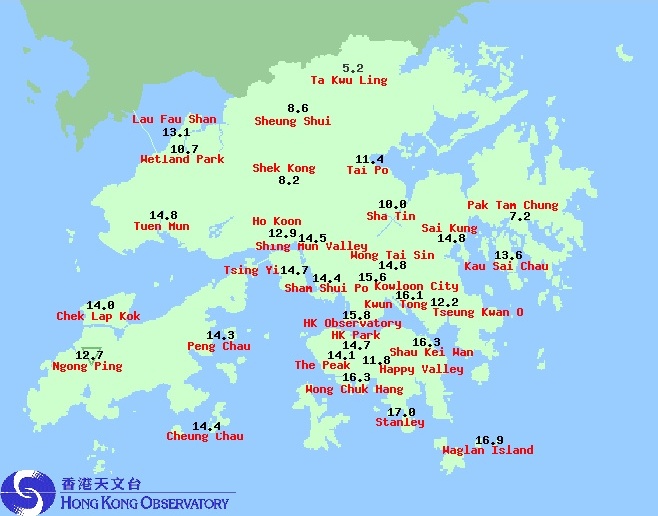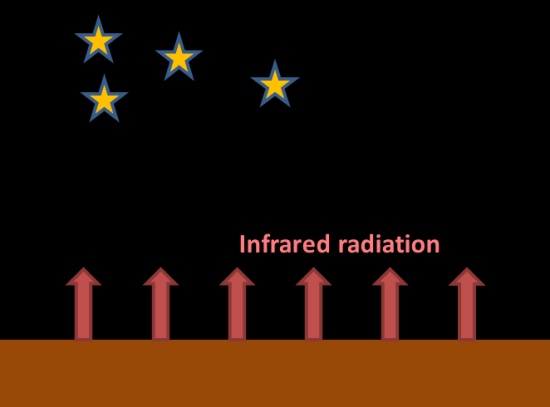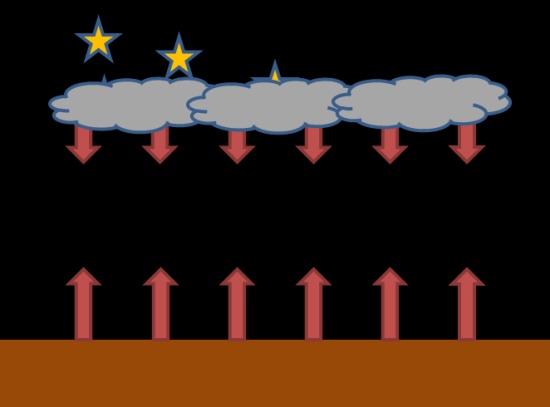Why is my home colder?
18 December 2013
Under the influence of the winter monsoon, the weather remained fine and cool in Hong Kong from late November to early December this year. You might have heard of weather reports like "the minimum temperature in the morning will be certain degrees in the urban areas, and a few degrees lower in the New Territories" during these days. For example, while the minimum temperature recorded at the Observatory in the morning of 5 December was 15.8 degrees, those over parts of the New Territories such as Ta Kwu Ling, Pak Tam Chung, Shek Kong and Sheung Shui were all below 10 degrees (Figure 1). What caused the large regional difference in temperatures within such a small place like Hong Kong?

Figure 1Minimum temperatures at various locations of Hong Kong in the morning of 5 December 2013.
Generally speaking, the ground releases heat to the sky at night in the form of infrared radiation. The temperature of the ground drops as a result of the loss of heat. Since heat is transferred by way of radiation and does not require any matter to serve as the medium, this weather phenomenon is known as "radiation cooling". Its effect is most prominent when there are less clouds and winds are light (Figure 2). Over exposed inland areas in the New Territories such as Ta Kwu Ling and Shek Kong, there are no tall buildings to trap the heat during the day and block the release of heat at night. They are also far away from the coast so that temperature will not be moderated by the air over warmer sea. Consequently, radiation cooling is more prominent and temperatures are lower over inland areas, when compared with coastal areas. For the same reason, air temperatures over exposed inland areas rise more quickly during daytime, leading to a large temperature difference between day and night.

Figure 2At clear night, temperature drops as the ground releases heat to
the sky in the form of infrared radiation.
However, if there are more clouds at night, the temperature drop will not be that significant even over exposed rural area. This is because cloud layer, acting like a blanket, blocks and absorbs part of the heat transferred from the ground to the sky, and then re-emits it to the ground (Figure 3). Similarly, moist air near the ground can also slow down the cooling of the ground. Furthermore, strong winds facilitate the mixing of warmer air aloft and cooler air near the ground, slowing down the cooling process as well.

Figure 3Cloud layer blocks and absorbs part of the heat transferred from the ground to
the sky, and then re-emits it to the ground.
Besides radiation cooling, the complex landscape in Hong Kong also contributes to regional temperature difference. Let us take Pak Tam Chung weather station, which is situated in a valley, as an example. Cooler air over the hillsides at night sinks along the slope due to its higher density and accumulates in the valley. As a result, temperature recorded at Pak Tam Chung could be a few degrees lower than that recorded at neighbouring weather station such as Sai Kung. We can see from this example that air temperature depends on a number of meteorological and local geographical factors, and may differ considerably between places just several kilometres apart.
Now being in December, weather has already become cold. If you live in exposed area in the New Territories and there is a fine and dry day with light winds, remember to keep yourself warm at night so as not to get a cold. Furthermore, as temperatures can vary significantly across different parts of Hong Kong, the Observatory will soon launch an automatic regional weather forecast to complement the territory-wide weather forecast. Stay tuned for this new service and obtain the weather information that best suits your needs.
TS Tsoi

Figure 1Minimum temperatures at various locations of Hong Kong in the morning of 5 December 2013.
Generally speaking, the ground releases heat to the sky at night in the form of infrared radiation. The temperature of the ground drops as a result of the loss of heat. Since heat is transferred by way of radiation and does not require any matter to serve as the medium, this weather phenomenon is known as "radiation cooling". Its effect is most prominent when there are less clouds and winds are light (Figure 2). Over exposed inland areas in the New Territories such as Ta Kwu Ling and Shek Kong, there are no tall buildings to trap the heat during the day and block the release of heat at night. They are also far away from the coast so that temperature will not be moderated by the air over warmer sea. Consequently, radiation cooling is more prominent and temperatures are lower over inland areas, when compared with coastal areas. For the same reason, air temperatures over exposed inland areas rise more quickly during daytime, leading to a large temperature difference between day and night.

Figure 2At clear night, temperature drops as the ground releases heat to
the sky in the form of infrared radiation.
However, if there are more clouds at night, the temperature drop will not be that significant even over exposed rural area. This is because cloud layer, acting like a blanket, blocks and absorbs part of the heat transferred from the ground to the sky, and then re-emits it to the ground (Figure 3). Similarly, moist air near the ground can also slow down the cooling of the ground. Furthermore, strong winds facilitate the mixing of warmer air aloft and cooler air near the ground, slowing down the cooling process as well.

Figure 3Cloud layer blocks and absorbs part of the heat transferred from the ground to
the sky, and then re-emits it to the ground.
Besides radiation cooling, the complex landscape in Hong Kong also contributes to regional temperature difference. Let us take Pak Tam Chung weather station, which is situated in a valley, as an example. Cooler air over the hillsides at night sinks along the slope due to its higher density and accumulates in the valley. As a result, temperature recorded at Pak Tam Chung could be a few degrees lower than that recorded at neighbouring weather station such as Sai Kung. We can see from this example that air temperature depends on a number of meteorological and local geographical factors, and may differ considerably between places just several kilometres apart.
Now being in December, weather has already become cold. If you live in exposed area in the New Territories and there is a fine and dry day with light winds, remember to keep yourself warm at night so as not to get a cold. Furthermore, as temperatures can vary significantly across different parts of Hong Kong, the Observatory will soon launch an automatic regional weather forecast to complement the territory-wide weather forecast. Stay tuned for this new service and obtain the weather information that best suits your needs.
TS Tsoi